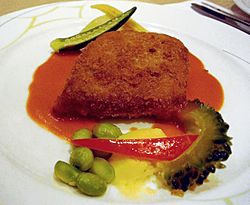À la Maréchale facts for kids

Veal cutlet à la Maréchale
|
|
| Course | Main |
|---|---|
| Place of origin | France |
| Serving temperature | hot |
| Main ingredients | Meat or fish, eggs, bread crumbs |
À la Maréchale is a special way to cook food in French cooking. The name means "marshal-style" in French. This cooking method uses tender pieces of meat or fish. These can be cutlets, escalopes, or chicken breasts.
To prepare food à la Maréchale, the meat or fish is first coated. It gets a layer of eggs and then bread crumbs. After that, it is sautéed, which means it's cooked quickly in a little fat.
Contents
History of À la Maréchale
When the Dish Began
This cooking style has been around since at least the 1700s. Some people think it might be named after the Maréchale de Luxembourg. She was a famous hostess in France during the 1700s.
A food historian named William Pokhlyobkin had another idea. He said the dish was so tender that "even a marshal" could eat it. A marshal was often seen as an older person who might not have strong teeth.
Different Ways to Make It
Many cookbooks from the 1800s describe different versions of À la Maréchale. Famous chefs like Marie-Antoine Carême and Alexis Soyer included recipes. They used various kinds of meat, poultry, and fish.
Some recipes even had stuffed versions. For example, "rabbit à la Maréchale" could be filled with duxelles (a mix of mushrooms). "Fowl fillet à la Maréchale" might be stuffed with truffles and herbs.
À la Maréchale in Russia
After France's defeat in 1814, À la Maréchale dishes came to Russia. Russian cookbooks often featured fancy versions. These often used hazel grouse fillets.
One early Russian cookbook suggested combining hazel grouse with veal liver. Later, a very popular cookbook from 1861 included "hazel grouse à la Maréchale." This version was stuffed with a special sauce, portobello mushrooms, and truffles.
Name Changes in Soviet Times
In the Soviet Union, around the 1920s, there was a plan to change many traditional restaurant names. They wanted to replace fancy French names with simpler ones. So, À la Maréchale was often renamed.
For example, "chicken or game fillets à la Maréchale" became "chicken or game cutlet stuffed with milk sauce." Because of this, the term À la Maréchale slowly disappeared from Soviet restaurant menus.
Truffles and Breadcrumbs
The famous chef Auguste Escoffier wrote about À la Maréchale in his cookbook. He noted that coating the food with eggs and breadcrumbs was a common way to make it. However, he suggested that the original way might have used chopped truffles instead. Breadcrumbs became a more affordable choice.
Today, dishes à la Maréchale are often served with truffles and green asparagus tips.
Related dishes
The dish called côtelette de volaille is similar to À la Maréchale. This dish is known as the ancestor of chicken Kiev. It is prepared in a similar way to game cutlets à la Maréchale. The main difference is that côtelette de volaille uses chicken, while côtelette à la Maréchale uses game birds like grouse.

